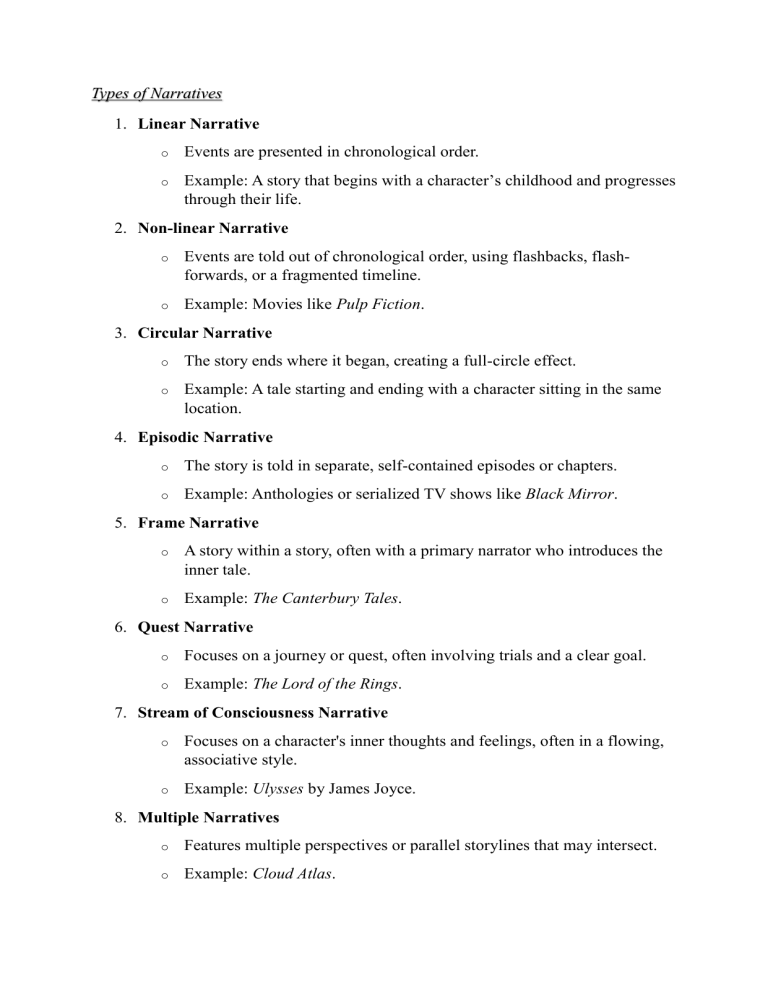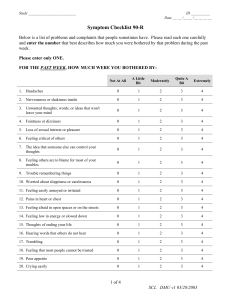Uploaded by
emirsali0101
Types Of Narratives and Point of Views

Types of Narratives 1. Linear Narrative o Events are presented in chronological order. o Example: A story that begins with a character’s childhood and progresses through their life. 2. Non-linear Narrative o Events are told out of chronological order, using flashbacks, flashforwards, or a fragmented timeline. o Example: Movies like Pulp Fiction. 3. Circular Narrative o The story ends where it began, creating a full-circle effect. o Example: A tale starting and ending with a character sitting in the same location. 4. Episodic Narrative o The story is told in separate, self-contained episodes or chapters. o Example: Anthologies or serialized TV shows like Black Mirror. 5. Frame Narrative o A story within a story, often with a primary narrator who introduces the inner tale. o Example: The Canterbury Tales. 6. Quest Narrative o Focuses on a journey or quest, often involving trials and a clear goal. o Example: The Lord of the Rings. 7. Stream of Consciousness Narrative o Focuses on a character's inner thoughts and feelings, often in a flowing, associative style. o Example: Ulysses by James Joyce. 8. Multiple Narratives o Features multiple perspectives or parallel storylines that may intersect. o Example: Cloud Atlas. Points of View 1. First-Person Point of View o Narrator: "I" or "we." The story is told from the perspective of a character. o Strengths: Intimate and personal. o Example: The Catcher in the Rye by J.D. Salinger. 2. Second-Person Point of View o Narrator: "You." The reader is directly addressed as the protagonist. o Strengths: Immersive and unique. o Example: Choose Your Own Adventure series. 3. Third-Person Limited Point of View o Narrator: "He," "she," or "they," focusing on the thoughts and feelings of one character. o Strengths: Offers insight into one character while maintaining some distance. o Example: Harry Potter series. 4. Third-Person Omniscient Point of View o Narrator: "He," "she," or "they," with insight into the thoughts and feelings of multiple characters. o Strengths: Expansive and all-knowing. o Example: Anna Karenina by Leo Tolstoy. 5. Third-Person Objective Point of View o Narrator: Neutral observer with no access to characters' thoughts or feelings, only actions and dialogue. o Strengths: Impartial and allows readers to interpret events. o Example: Plays or screenplays often adopt this style. 6. Unreliable Narrator o Can be first-person or third-person but is not trustworthy due to bias, ignorance, or deception. o Strengths: Adds layers of complexity and ambiguity. o Example: Gone Girl by Gillian Flynn. 7. Alternating Points of View o Shifts between different narrators or perspectives. o Strengths: Provides a broader understanding of the story. o Example: A Song of Ice and Fire by George R.R. Martin.
